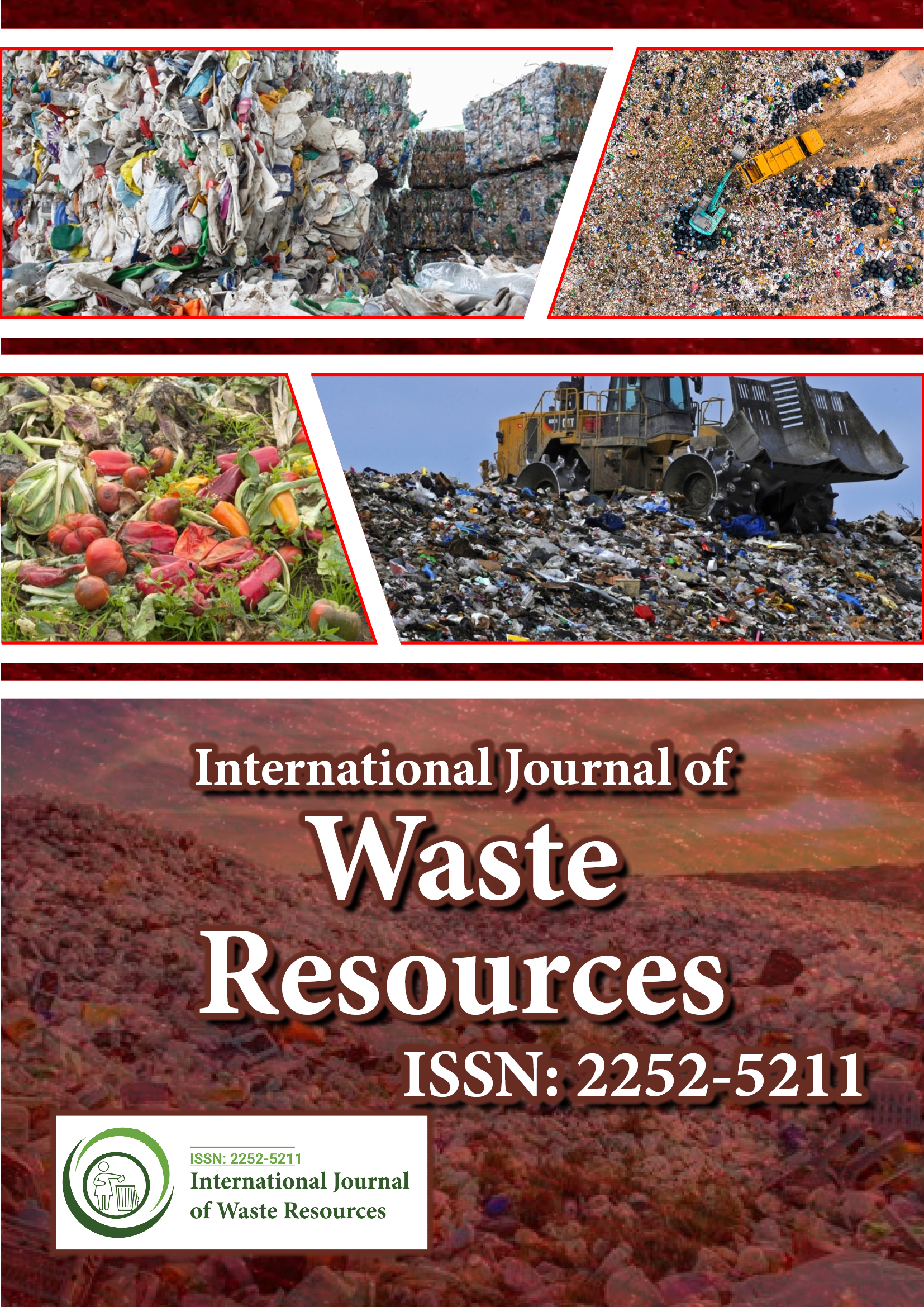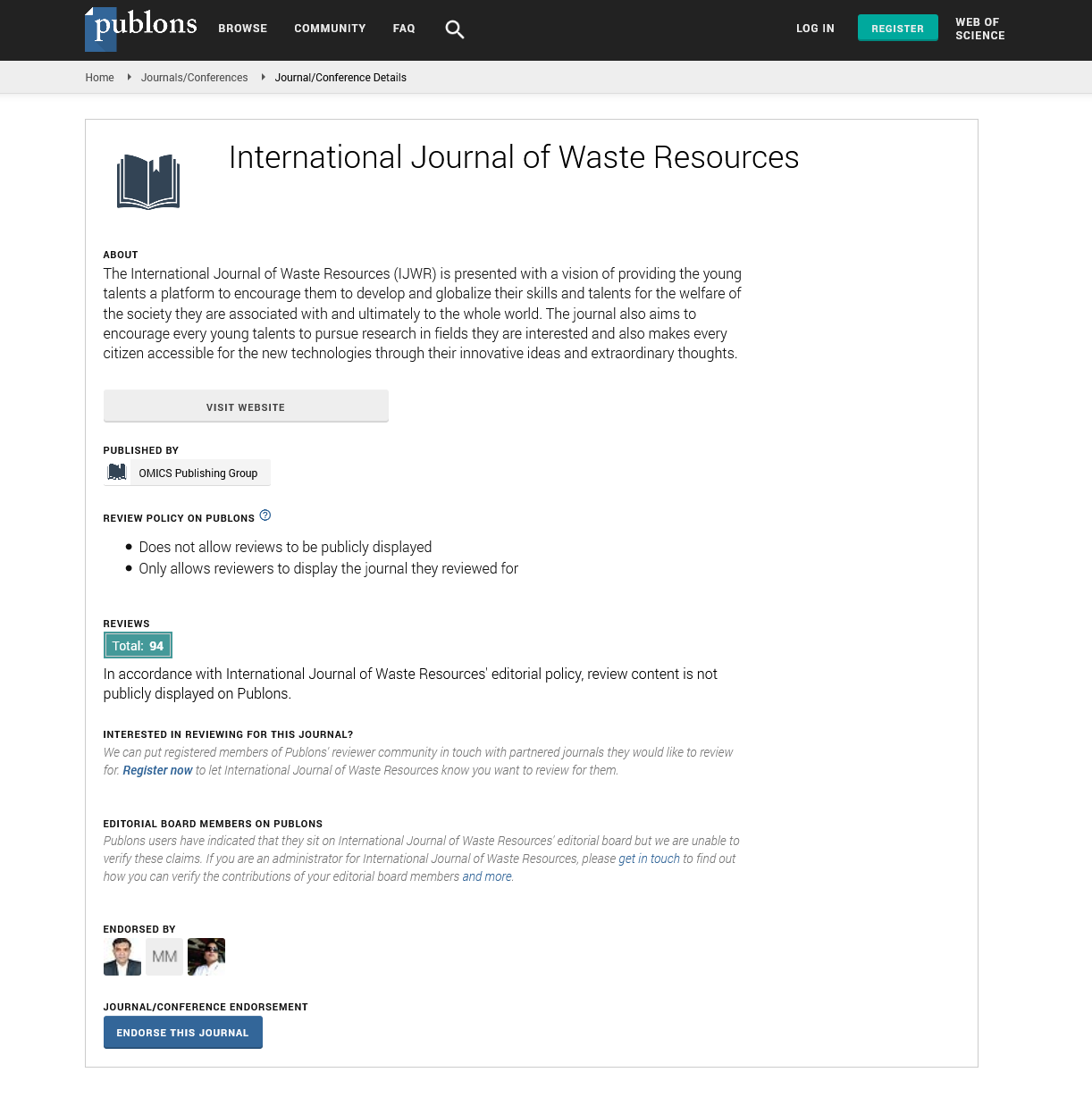Indexed In
- Open J Gate
- The Global Impact Factor (GIF)
- Open Archive Initiative
- VieSearch
- International Society of Universal Research in Sciences
- China National Knowledge Infrastructure (CNKI)
- CiteFactor
- Scimago
- Ulrich's Periodicals Directory
- Electronic Journals Library
- RefSeek
- Directory of Research Journal Indexing (DRJI)
- Hamdard University
- EBSCO A-Z
- Publons
- Google Scholar
Useful Links
Share This Page
Journal Flyer

Open Access Journals
- Agri and Aquaculture
- Biochemistry
- Bioinformatics & Systems Biology
- Business & Management
- Chemistry
- Clinical Sciences
- Engineering
- Food & Nutrition
- General Science
- Genetics & Molecular Biology
- Immunology & Microbiology
- Medical Sciences
- Neuroscience & Psychology
- Nursing & Health Care
- Pharmaceutical Sciences
Commentary - (2025) Volume 15, Issue 1
Effective Strategies for Managing Recyclable Waste to Promote Sustainability and Protect Our Environment
Pitro Liuzi*Received: 31-Jan-2025, Manuscript No. IJWR-25-29247; Editor assigned: 03-Feb-2025, Pre QC No. IJWR-25-29247; Reviewed: 14-Feb-2025, QC No. IJWR-25-29247; Revised: 21-Feb-2025, Manuscript No. IJWR-25-29247; Published: 03-Mar-2025, DOI: 10.35248/2252-5211.25.15.601
Description
In today’s rapidly evolving world, the mounting generation of waste has emerged as a critical environmental concern. Among the many solutions, recycling stands out as a key strategy to reduce the strain on landfills, conserve natural resources and minimize pollution. Recyclable waste includes materials that, once discarded, can be processed and transformed into new products, rather than being sent to landfills or incinerated. This process allows materials to re-enter the manufacturing cycle, significantly reducing the demand for raw resources and energy. Common recyclable materials include paper, plastics, metals, glass and specific electronic components.
Paper and cardboard, widely used in everyday life, are among the most commonly recycled materials. Items such as newspapers, packaging boxes and office documents, when recycled, help preserve forests and significantly reduce water and energy consumption required for producing new paper. Plastics, while highly versatile, pose a significant environmental challenge due to their resistance to degradation. However, certain types such as Polyethylene Terephthalate (PET) bottles and High-Density Polyethylene (HDPE) containers can be effectively recycled, provided they are properly sorted, as not all plastic materials are recyclable. Metals like aluminum, steel and copper are infinitely recyclable without loss of quality and recycling them consumes far less energy compared to mining and refining new metal ores. Glass items, such as bottles and jars, can also be recycled repeatedly without degradation, making glass an environmentally friendly material when disposed of properly. In the case of electronic waste, which includes devices like smartphones and computers, several components such as circuit boards, batteries and valuable metals can be recovered. Proper handling of e-waste is essential to prevent the release of hazardous substances into the environment.
The recycling process typically begins with the collection of recyclable materials from households, businesses and public collection points. Once gathered, the materials undergo sorting by type and quality through a combination of manual labor and automated systems. After sorting, any contaminants like food residues or adhesives are removed through cleaning. The clean materials are then processed—shredded, pulped, or melted depending on their composition. These processed materials are used to manufacture new products, which are eventually purchased by consumers. Completing the cycle, the demand for goods made from recycled materials reinforces the effectiveness and sustainability of recycling systems.
Recycling brings a multitude of environmental, economic and social benefits. By diverting waste from landfills, it reduces land and water contamination while lowering methane emissions from organic decomposition. It helps conserve natural resources such as trees, minerals and fossil fuels, thereby supporting the stability of natural ecosystems. Energy use is significantly reduced during the manufacturing of goods from recycled inputs, leading to fewer greenhouse gas emissions. Economically, recycling creates jobs across various sectors including collection, processing and manufacturing, while also reducing municipal waste management expenses. Moreover, recycling lessens pollution levels by minimizing the need for raw material extraction and processing.
Despite its clear advantages, recycling systems face notable challenges. One major issue is contamination, where non-recyclable items are mixed with recyclables, decreasing the quality and usability of entire batches. Public awareness about what can and cannot be recycled remains inconsistent, leading to improper disposal practices. Many regions still lack sufficient infrastructure or access to reliable recycling facilities, particularly in rural or under-resourced areas. The economic viability of recycling is also influenced by fluctuating market prices and demand for recycled materials. Additionally, modern consumer goods are often made from complex combinations of materials that are difficult to separate and recycle efficiently.
The success of recycling relies heavily on the active participation of individuals and communities. People can make a difference by educating themselves about local recycling guidelines, reducing waste generation and reusing items before resorting to recycling. Ensuring that recyclables are clean and properly sorted greatly increases the chances of successful processing. Supporting local recycling programs and advocating for improved infrastructure also strengthens community-level efforts. Choosing to purchase products made from recycled materials further stimulates the market and encourages manufacturers to prioritize sustainability.
Conclusion
Emerging innovations are gradually addressing many of the current limitations in recycling. Technologies such as AI-driven robots are enhancing the accuracy and efficiency of sorting facilities. Chemical recycling methods are being developed to break down plastics at a molecular level, making it possible to recycle materials that are otherwise too complex for conventional methods. New circular economy models are encouraging companies to design products with end-of-life recyclability in mind, promoting longer life cycles and easier disassembly. Integrating recycling with waste-to-energy systems also ensures that residual waste is managed in a productive and environmentally friendly way. Ultimately, managing recyclable waste effectively is a critical step toward achieving a sustainable and environmentally responsible society. With growing awareness, technological advancements and strong community participation, the vision of a circular economy can become a reality. Through consistent individual actions and collective efforts, we can protect natural resources, reduce environmental degradation and move toward a greener, healthier future.
Citation: Liuzi P (2025). Effective Strategies for Managing Recyclable Waste to Promote Sustainability and Protect Our Environment. Int J Waste Resour: 15:601.
Copyright: © 2025 Liuzi P. This is an open-access article distributed under the terms of the Creative Commons Attribution License, which permits unrestricted use, distribution and reproduction in any medium, provided the original author and source are credited.

